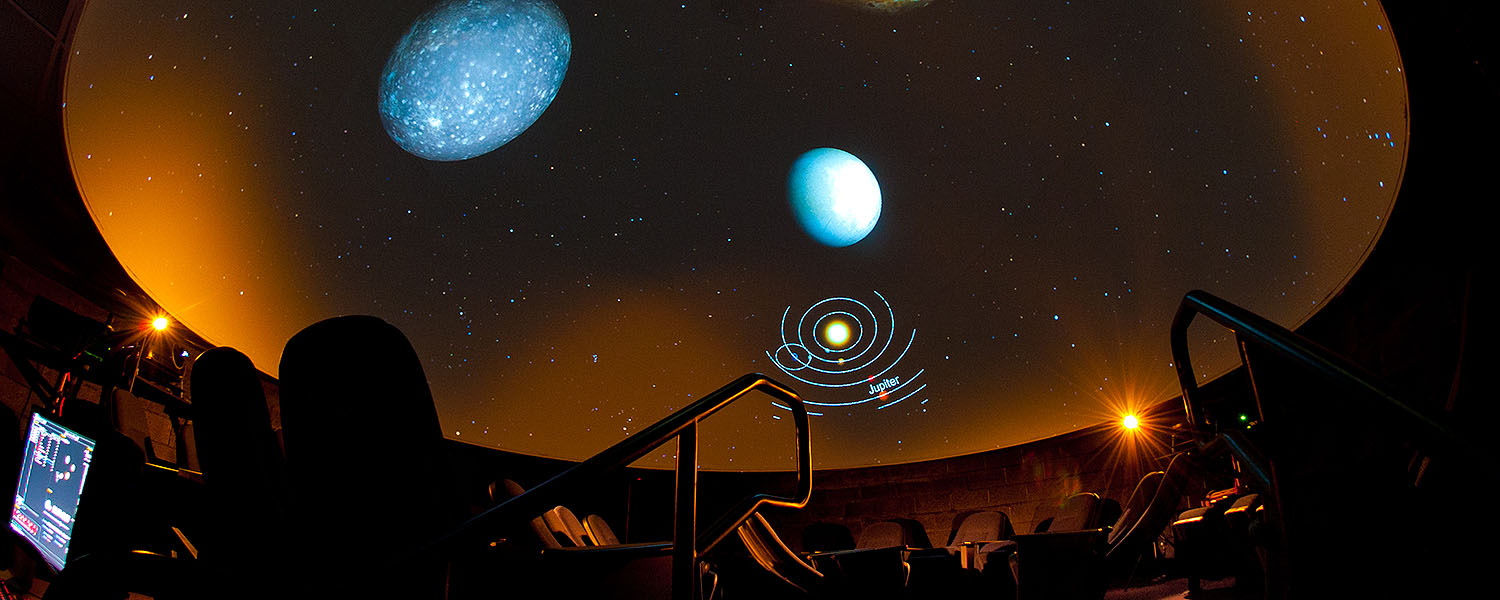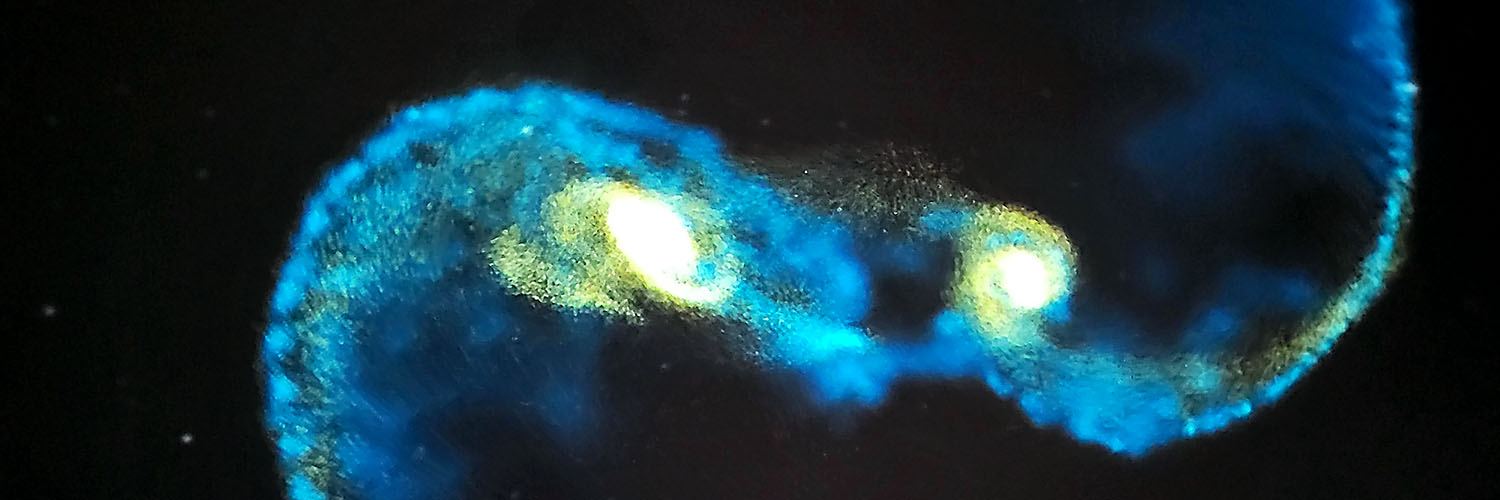Clemson University Planetarium
 Clemson University
Clemson University
Astronomy Outreach
The Department of Physics and Astronomy maintains a digital planetarium in Kinard Laboratory 112 and has access to telescopes for observing events on Clemson’s main campus. The planetarium is the star of our outreach program and is equipped with a highly advanced, full-dome digital theater system — the Digistar 7. The new theater system, installed in 2022, has redefined what’s possible in a digital planetarium with its advanced user interface, enhanced real-time rendering capabilities and 4K full-dome video playback. With Digistar 7, the planetarium operators have a wide range of storytelling tools available to customize presentations for any audience.
The planetarium is operated on a volunteer basis. Faculty members and graduate students are involved in the production of shows. The planetarium seats up to 38 visitors and can accommodate up to three wheelchairs. The Physics and Astronomy department is happy to share the planetarium experience with the public at free planetarium shows held during the academic year. Interested parties can also reserve the planetarium for private customizable shows at a small cost. The planetarium is a great experience for school field trips, birthday parties, or any other celebration or event you would like to take out of this world.
Email PandAOR@clemson.edu with any questions about your visit.
Explore the Planetarium
Visiting the Planetarium
-
Parking
Parking on campus can be difficult, so it is important to plan ahead to arrive at your show on time. Review your parking options on the parking services webpage. See the details page for public events or private events for suggestions based on your group size and show time.
-
Entry
Clemson University currently has locked doors with key-card access. You will need to be let into the building if you are not a Clemson employee or student. You should plan to meet the presenter on the north side (Sikes Hall lot side) of the Kinard Laboratory building (labeled the “PHYSICS” building) next to the pendulum tower.
Ideally, find your way to the first floor (not the ground floor); the base of the pendulum will be one floor down. Search for “Clemson Focault Pendulum Tower” on Google Maps for a precise location. The presenter will check this door for visitors prior to the start of the show.
-
Seating
The planetarium contains 38 reclining seats with room for two wheelchairs or additional seating.
Seats can be reserved for a public show on a first-come, first-served basis through the seat reservation link on the Public Events page. The link for reserving a seat at a public show will open one week before the show.
For private groups larger than 40, multiple shows will be required. Please see the Private Events page for information on how to request shows for large groups.
-
During the Show
Food and drinks are not permitted in the planetarium space except for water bottles. We ask that you silence your phones prior to entry as sounds travel very well inside the dome and any lights from phone screens will disrupt the show. Questions are encouraged during the private shows, but please limit them to when the presenter pauses for questions so that the show can stay on schedule.
Directions
Planning a visit? The planetarium is located in Kinard Laboratory 112. Kinard Laboratory is behind Sikes Hall and Long Hall. Take S.C. Highway 93 to Cherry Road, and then turn onto Parkway Drive (by the President’s House). Follow Parkway Drive to the parking lot between Sikes Hall and Long Hall. Kinard is located behind Long Hall.

Planetarium History
The Early Days
Shortly after the opening of Kinard Laboratory in 1961, the planetarium was installed. The unexpected upgrade to a Spitz A3P projector required a 24-foot diameter dome, which did not quite fit in the provided space. The fiberglass panel dome had to be truncated, with a flat vertical portion on the south side. A wooden platform was constructed around the central projector well, and bench seats were installed.
Most of this work was performed by faculty members, including the long-serving Tom Collins and John Gilreath. The projector was an amazing optical-mechanical machine. An arc lamp inside the star ball projected nearly 3,000 stars through pin holes and lenses for the brighter ones. It also showed the Milky Way and the Andromeda galaxies.
The sky could be shown for any place and time, by rotating the star ball and changing its elevation angle. Small projectors displayed the sun, moon, terrestrial images and giant planets. Rotating and pivoting mirrors tied to the motion of the projector by systems of gears accurately positioned these bodies for any time over many centuries. All of this was controlled with analog electronics by the operator, in the dark, via a set of dials and switches. Separate special effects projectors, which showed a solar system orrery, a polar orbiting satellite, a meteor shower, a solar eclipse, and various coordinate lines and grids, were added.
Approximately 100,000 visitors attended planetarium shows over the years. It was closed in 1994 for budgetary reasons, but with contributions from doctorate students Peter Milne and Grant Williams, it was reopened as an all-volunteer operation. Finally, the decision was made to renovate the planetarium and upgrade the equipment. In December 2010, it was closed, and everything except the dome, including floor and seats, was removed from the room. The second-floor stockroom that intruded into the original dome was removed.
The Next 50 Years
The fiberglass hemisphere was completed, and a new platform, seats, electrical, flooring, and paint were added. The new projection system selected, a fully digital Digistar 4 by Evans and Sutherland, was installed in March 2011.
April 2022 marks the most recent update to the system with the installation of the Digistar 7 system by Evans and Sutherland. While the dome remained the same all of the electronic and projector hardware was updated.
Two 4K laser phospher projectors on opposite sides of the dome cover it with images, which are generated on a dedicated workstation for each. Another workstation controls the display system. Anything that can be generated on the computers can be displayed on the dome. The standard database includes nearly 1 million astronomical objects with locations in three dimensions and other properties. Many are three-dimensional objects themselves, and all can have images placed on them. The view from anywhere can be displayed. We can fly among the planets, then, speeding along at faster than light, fly among nearby stars, out to nearby galaxies, and even to the edge of the observable universe.
With terrain maps of the Earth, moon and Mars, we can fly over the surface and view the most recent high-resolution terrain features. With built in multidisciplinary content and a highly verstile show building interface the Planetarium is not just for astronomy. Contact the department if you are interested in showing your educational discipline in this unique space.
Shows can be controlled with point and click GUIs, or with scripted commands. The images displayed can be recorded and replayed as full-dome video. Professionally produced video can also be purchased from other sources or downloaded from the global cloud of Planetarium resources. A domecasting features allows us to livestream the show of another planetarium anywhere in the world.
The renovation was funded by student lab fees with substantial contributions from thefrom the College of Engineering and Science and the Office of the Provost.
Seeking Support
The Department of Physics and Astronomy is seeking additional support from private donors for paying student presenters and purchasing additional full-dome shows. Contact the department to arrange to see a show or to make a gift.
